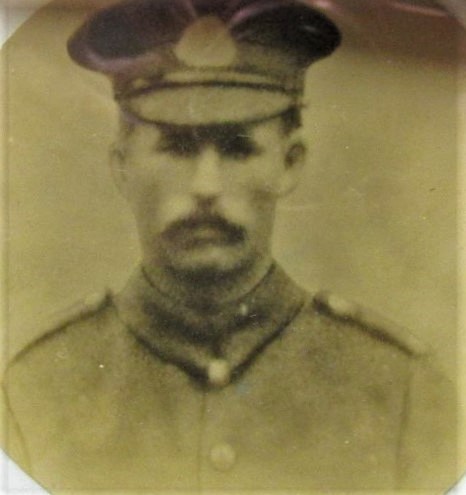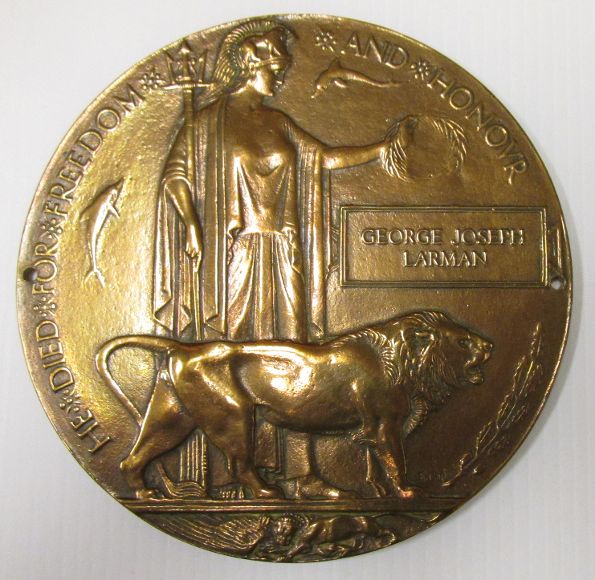43256 PRIVATE GEORGE JOSEPH LARMAN
7TH (SERVICE) BATTALION SUFFOLK REGIMENT
KILLED IN ACTION
10TH APRIL 1917
AGE 31 YEARS
Born in Halesworth during the later months of 1886 George was the fifth child and first son of a family that would eventually grow in size to eight children, born to Rosanna (née Baggot) and her husband, also named George, a coach body maker. As with several young men from the town, very little information could be found of young George’s early life, other than that by the time of the 1901 census, he remained living with the family at 67 London Road and had found work as an errand boy employed by the local chemist. It appears that he then spent some seven years working for Dennington and Co. Ltd., manufacturers of sacks, ropes and tentage at their works, also in London Road. By the time of the next census in 1911, George had left the town and was now to be found at sea, employed as a ship’s cook on the Lowestoft fishing boat ‘Successful’ which at the time of the census, was operating out of the port of Padstow on the Cornish coast.
Shortly after Great Britain’s declaration of war against the Kaiser’s Germany in August 1914, George must have returned home as the Halesworth Times newspaper of 6th October 1914, reporting on men from the town who had volunteered to serve in the army during the previous week, included George. Further research shows that he, with a small group of other volunteers, had been sent to the nearby town of Saxmundham where they had been enlisted to serve in the 6th (Cyclist) Battalion, Suffolk Regiment, Territorial Force with George becoming 1747 (later 43256) a Private Soldier. Just a month prior to their joining, the original battalion had been split to form a second unit, becoming the 1st/6th and the 2nd/6th Battalions. Both retained their cyclist roles, enabling them to carry out their duties of patrolling areas of the eastern coastline, observing for any attempts of invasion from across the North Sea. Which of the two battalions George had been posted to is not known? The 1/6th Suffolks remained to watch over the Suffolk coast between the Deben and Blyth rivers, while, in November 1914 the 2/6th Suffolks were despatched to Louth in Lincolnshire where they carried out patrols along that county’s coastline. As a secondary role, both battalions were expected to train their recently enlisted recruits. This was followed in June 1915 with the task of supplying drafts of replacements for the Suffolk battalions fighting in France and Belgium.
After almost two years of service with the Suffolk Cyclists (confirmed in the notice of George’s death published in the Halesworth Times of 24th April 1917) it appears that he had been included in a draft of men that had crossed to France in September 1916 to join the 7th (Service) Battalion, Suffolk Regiment as a casualty replacement after the losses they had suffered during the early Somme battles. Although possibly looked down on by the men of the 7th Suffolks who had been in France for over a year and regarded these men who had spent some time living a comfortable life patrolling the coast of East Anglia, the replacements soon showed their worth. It is a tribute to the quality of the men from both battalions of the 6th Suffolks Cyclists that, in the Suffolk Regimental history of the Great War published in 1928, comments made by the General Officer Commanding the 12th (Eastern) Division, in which he stated: – “That they are considered the very best of men, they ever had, being well trained, with great hearts”. The history also related that the vast majority of the replacements were almost entirely Suffolk-born men, with the majority originating from Lowestoft and the surrounding area.
The previously mentioned newspaper article also noted that George, by late July 1917, had spent some nine months in France, during which time he had on two occasions been admitted to a Military Hospital. Whether these were due to wounds or illness is not known.
Leading up to Easter Monday on 9th April 1917, the 7th Suffolks had spent the first few days of the month behind the lines carrying out training, after which they moved into the remains of the French town of Arras. On their arrival they were directed to what were claimed to be billets, located in the natural caves beneath the town’s museum. These, it was reported, they found to be dirty and damp. Nonetheless here they remained for the next three days, during which time they prepared for the forthcoming battle. During their time underground the weather had taken a severe turn for the worse, with a heavy snowfall and frost. On the morning of Easter Monday, they emerged from the caves and moved into the front line, to take their part in what later became known as the First Battle of the Scarpe. This was to be a major British assault over several miles of front. The 7th Suffolks’ role, together with their flanking partners of the 9th Essex, was to follow up the 7th Norfolks and 5th Royal Berkshires who had been designated as the leading battalions of their Brigade. This tactic then allowed, in the event of those leading the assault becoming held up for any reason, for the follow-up companies to then pass through them to continue the attack. The leading battalions left the British front line at 12.15pm with it being reported that the first German line were captured by 1.05pm when, to the cheers of our own men, the defenders were seen to be retreating in much disorder. It would have been then that the Suffolks and the men from Essex took over the lead, but, shortly after, they were held up by a second line of barbed wire entanglements backed up by several machine gun emplacements. After several attempts at cutting through the wire by hand, the men were then ordered to withdraw back a short distance to form a temporary line alongside the road leading to the village of Feuchy. While lying out in the open, the weather continued to get far worse with a heavy fall of snow and sleet making the troops suffer terribly. Around midnight of 9th and 10th April the men were pulled further back in preparation for a major artillery barrage to be laid on at first light with the aim of silencing the machine guns and also breaching the enemy’s wire defences. By midday gaps in the wire could be seen and the 7th Suffolks continued their assault to capture their final objective which was accomplished shortly after.
The number of casualties suffered by the battalion during those two days was later reported as being some four hundred and seventy all ranks killed, wounded, and missing, George being in the latter group as, even if his body had been found, he could not be identified. Today he is remembered with six hundred and thirty-seven other members of the Suffolk Regiment from across five separate battalions on the Arras memorial to the missing.
As if the sad news of the loss of George were not enough for his parents to bear, within less than two weeks they would hear from the authorities that Arthur, the younger brother of George, had been made a Prisoner of War while serving with the Machine Gun Corps on 24th April 1917. George senior and Rosanna had previously had concerns with regard to Arthur after he received a gunshot wound to his shoulder on 11th March 1915, while fighting with his friends of the Halesworth Territorials during the battle of Neuve Chapelle. After recovering from his wounds, he was transferred to the Machine Gun Corps with whom he was captured. Fortunately, after suffering for over a year as a P.O.W., he returned home to his family on 6th December 1918.
On 23rd July 1919 George senior received the second war gratuity payment for the loss of his son. This then amounted to a total of £22.16s.7d (£22.83p).
As well as the financial award, they were also able to claim George’s medal entitlement of the British War and Victory medal pair with his named memorial plaque and scroll.
The memorial plaque and scroll have since been presented to the Halesworth and District Museum.


